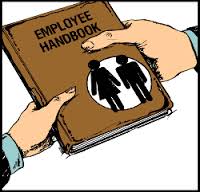The advantage is clear communication. Everyone, including the managers, knows what the company’s policies are and how they are administered. This helps eliminate problems because employees know what they can and cannot do. Managers can administer policies fairly because they are clearly spelled out.
Not having a manual can cause chaos. Two employees may be disciplined significantly differently for doing the same thing, which is not fair. Managers can make poor termination decisions, resulting in potential lawsuits.
What is the disadvantage? The company has to stick to it, at least until the manual is updated and redistributed to all employees. You may lose some flexibility in administering policies.
If a business has two employees, this is probably not a big deal. If it has many employees, I can’t imagine why they would want to be without it. In my opinion, the advantages clearly outweigh the disadvantages.
Employee Handbook: How Well Does It Protect Your Company?
Employers often wonder whether they ought to have an employee handbook. There are both advantages and disadvantages to a handbook, but overall many employers come out on the side of having one. Handbooks can establish clear standards that help reduce disputes; promote consistent management; inform new employees of the company’s policies; demonstrate a commitment to equal treatment of personnel; and reduce the chances of unintentional illegal behavior.
The disadvantages to having a handbook, most of which can be reduced or eliminated with proper phrasing of policies, include discovering that the handbook forms the basis of an employment contract, and/or that it limits the company’s ability to handle situations on a case-by-case basis.
Employers that want a handbook, but also want to reduce the likelihood of its being used against them at a future date must be certain to have a properly worded disclaimer prominently displayed in it. Although such a disclaimer cannot guarantee that a disgruntled employee will not sue for breach of contract or wrongful discharge, it can be a deterrent against such claims being brought and, if brought, can be a helpful defense against them.
To be effective, the disclaimer must state in simple to understand language that the handbook is not intended to create an express or implied contract of employment. It must also state that all employment with the company is “at-will.” This means that either the employee or the employer may terminate employment at any time for any reason, with or without notice. In addition, the disclaimer should note the handbook is not intended to be a complete description of the company’s policies or practices and that the company reserves the right to revise, supplement, suspend or discontinue the policies at any time.
To avoid diminishing the effect of a disclaimer, employers should be careful not to make statements anywhere in a handbook that it is designed to clarify the “rights” of employees. Employers must also take particular care when adding disclaimers to existing handbooks. The addition of a disclaimer should be well publicized to best protect the company, and, even then, employers should be aware that the disclaimer may not be effective as to employees who were hired under previous editions of the handbook.
Employers should have employees sign an acknowledgment that they received a copy of the handbook and that they understand it is their obligation to read, understand and comply with it. The acknowledgment should reiterate that the handbook is not intended to create an express or implied contract and that all employment with the company is at-will.
Employers should also pay particular attention to disciplinary policies. Clearly drafted work rules that are adhered to consistently are an important component of an employer’s disciplinary policy. Such work rules can be used to defend against unemployment compensation claims as well as discrimination and wrongful discharge claims. Disciplinary policies that include reference to progressive discipline, such as verbal warnings followed by written warnings prior to termination, must contain language granting the employer flexibility to skip any or all steps in the disciplinary process when it deems it appropriate to do so.
Other important policies include sexual harassment and proper absentee control policies — both of which must comply with relevant law. For example, a sexual harassment policy should include a definition of sexual harassment. Employers of 50 or more employees must be certain that any absentee policy complies with the Family and Medical Leave Act.
Why a Company Should Have an Employee Handbook Learning the Pros and Cons?
In most states, employers are not required by law to issue an employee manual or handbook. The decision is largely a practical matter and not a legal one. In large part, this is due to the relative difficulty employees face in attempting to maintain lawsuits predicated on an employee manual (even a poorly drafted manual). Accordingly, an employer generally benefits from having an employee manual because the legal risks associated with adopting a manual are far less substantial than they otherwise would be if the at-will presumption was not as difficult for employees to overcome.
This does not mean, however, that there are no legal considerations that precede, or implications that flow from, an employer’s decision to adopt an employee manual. Once a decision to issue an employee manual has been made, certain requirements must be met. But, as detailed below, the pros of having a properly drafted manual should outweigh the cons. In short, there is more upside benefit to adopting a manual than downside risk. Moreover, most of the downside risk can be contained.
1. The Pros of Having an Employee Manual
A main advantage of issuing an employee manual is establishing uniform, well defined employment policies. Even the most novice human resource professional recognizes that the hallmark of good employee relations is standardized and consistently applied personnel policies. In its most basic format, an employee manual defines and codifies the employer’s standards. These defined and communicated standards allow employers, however large, to treat employees consistently on a long term basis.
Obviously, an employer need not have an employee manual to have uniform, well defined personnel policies. In practice, however, it is the adoption of an employee handbook that creates the uniformity and definition which allows for consistent application of the employer’s policies. Simply stated, most employers that do not have an employee manual also do not have standardized personnel policies. Creating an employee handbook focuses an employer’s attention on adopting across-the-board standards. Indeed, it is often the creation of a handbook that is the springboard for establishing a sophisticated (or more sophisticated) human resources function.
An employee manual is also the most convenient device for communicating established employer standards to the workforce. As most employers recognize, there is just not enough time to orient newly hired employees to their positions and communicate all that the employees need to know. This is particularly true given the ever growing number of forms that employers and employees must complete before the employee actually starts working. An employee manual or handbook allows employers to encapsulate its policies in a format that is easy to disseminate to the workforce.
Once distributed (and understood), the employee manual should establish a common understanding between employer and employee regarding performance standards and workplace behavior. Creating such a common expectation is, perhaps, the key advantage of issuing an employee manual. Most often, it is the lack of a common expectation that causes the breakdown in employee relations. This is certainly true for poor work performers. Clearly, there is no excuse for a break down of expectations regarding core issues like sick leave and pay day.
Last, but not least, an advantage of a properly drafted employee manual is the prevention of employee lawsuits. As detailed above, a manual that clearly states that it is not intended to create a contract will, in general, foreclose lawsuits for breach of the manual’s terms. In addition to preventing common law claims (such as breach of contract), a manual can reduce the risk of employment discrimination suits. This reduced risk is achieved by consistent application of the employee manual. Again, employers that have employee manuals and handbooks are much more likely to apply policies in a consistent manner, regardless of an employee’s traits such as age, gender or race.
In sum, some of the main advantages of a adopting an employee manual are:
- Establishing uniform, well-defined standards
- Creating a vehicle for disseminating the employer’s standards
- Establishing a common understanding and expectations regarding employer standards
- Reducing the risk of employee lawsuits
2. The Cons of Having an Employee Manual
Employee manuals do have downside risks. Some risks are management created and some are manual created. Management-created risks exist regardless of the quality of the manual, whereas manual-created risks exist because the manual is of poorly drafted.
a. Management-Created Cons
The downside risk to the standardization created by an employee manual is management inflexibility. Many employers enforce a black letter interpretation of their employee manuals. These employers simply ignore the fact that employee manuals cannot adequately address the infinite and ever changing issues that arise between employers and employees. This inflexibility phenomenon is most prevalent among mid-level managers who sometimes do not see the forest for the trees. Some of these managers forego common sense for easily applied, black letter standards. Others fear reprisal for failing to tow the company line.
The downside management-created risk at the opposite end of inflexibility is failure to uniformly apply the manual’s standards. While this risk always exists, a manual creates the presumption that standards will be uniformly applied. Nothing angers a workforce more than management’s failure to apply policies in a uniform manner. Even more dangerous, an employer’s failure to uniformly apply its handbook policies is often the reason an employee files a discrimination claim and the manual, in these cases, will invariably be used as evidence to support the claim. Accordingly, when an employer memorializes its policies, it must be prepared to follow them.
b. Manual-Created Cons
The primary manual-created disadvantages are products of poor drafting. An imprecise or ambiguous manual is an ineffective tool. It confuses both management and the workforce and often creates divergent expectations between the employer and employees. Equally troublesome is an employee manual that includes unlawful provisions. Despite the tremendous press coverage of employer-employee relations, many manuals contain provisions that are either unlawful on their face or allow for an unlawful application. For example, some manuals include provisions that restrict employment opportunities to disabled employees (e.g., “employees who are not physically able to perform their job will not be permitted to work”).
Another disadvantage is incompleteness. First, as indicated by the cases discussed above, some manuals contain a “just cause” or “discipline procedure” provision, but do not contain strong disclaimer language (i.e., “The manual is not, nor is it intended to be, a contract or a guarantee of employment, and does not change the long-standing right of either party to terminate the employment relationship at will.”). Without this language, employees (and plaintiff’s attorneys) are more prone to believe what the manual says, irrespective of the at-will presumption. Second, some laws, like the Family and Medical Leave Act of 1993, require that a covered employer include an FMLA policy in its manual. Failure to do so may impact the employer’s rights under the Act. Finally, in light of the recent Supreme Court decisions on sexual harassment, employers should ensure that their employee manuals contain effective anti-harassment policies. Again, employers that fail to include an anti-harassment policy in their manuals may forgo possible defenses to harassment claims.
Obviously, an inaccurate, unlawful or incomplete employee manual can spawn lawsuits. Even a poorly drafted manual which does not support an independent cause of action may be used as evidence to support another viable claim.
In sum, some of the main disadvantages of an employee manual are:
- Fostering management inflexibility
- Establishing standards to which management does not adhere
- Engendering workforce dissatisfaction due to imprecise or incomplete language
- Prompting or supporting employee lawsuits
Employee Handbook Design
An effective employee handbook introduces your organization and its philosophy to new employees and also acts as an effective, ongoing communications tool for information on organizational policies and procedures. A handbook is only useful if it’s easy to understand and the necessary disclaimers and language are compliance safe.
What are some of the advantages/disadvantages to developing an employee handbook?
Advantages
- Protect management
- Promote consistency
- Meet legal requirements
- Maintain employment “at-will”
- Maintain employer discretion
- Save time
Disadvantages
- Bound by contract
- Inconsistent application
- Inaccurate policies
If you have an existing handbook that needs updating, EA can review and make comments and recommendations for enhancement. If you are creating a handbook for the first time or require extensive modifications, an experienced consultant will:
- Meet with you to learn more about your organization’s philosophies
- Create new policies or adapt current policies (Employee Handbook Contents Checklist)
- Ensure that all policies are in compliance with State and Federal laws
- Provide language to lessen concern that the handbook is an employee contract
Conclusion
There are many advantages to creating employee handbooks. Employers generally benefit from increased communication with employees regarding company policies, benefits, and work rules. However, employers must be willing and able to honor commitments made in the handbook. Additionally, poorly drafted, maintained or enforced handbook policies can be the source of many problems for employers.
One advantage of an employee handbook is the improved communication between employers and employees. An employee handbook is an opportunity for the employer to communicate with its employees about work place practices and procedures. This is particularly helpful to new employees who can become better acquainted with work place practices at the outset of their employment.
An employee handbook is also a good location to communicate guidelines and policies under which a company operates. It is a source both for the employer to announce, clarify or change policies and also for the employee to look to for a common understanding of the company’s standards of conduct. In addition, the handbook can express the company’s mission and can contribute to the furtherance of the company’s corporate culture.
By understanding what the company expects of the employee and what the employee can expect of the company, an employee handbook helps to minimize anxiety of employees by decreasing fear of the unknown. The manual can clearly and specifically define everything from the nature and status of the employment relationship, to the ramifications and process which will be followed in the event of employee misconduct or poor performance.
Finally, the employee handbook offers an opportunity to state affirmatively and confirm that employment is at will, thereby possible insulating the company from many claims. This helps to put all parties on notice as to the nature, scope and rules of the working relationship from the outset.
















